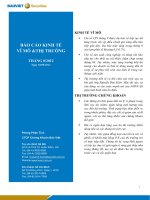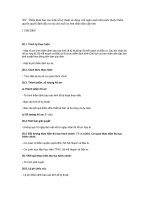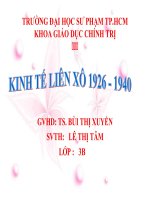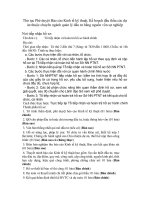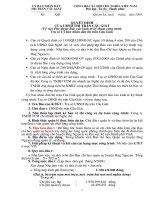báo cáo kinh tế lượng
Bạn đang xem bản rút gọn của tài liệu. Xem và tải ngay bản đầy đủ của tài liệu tại đây (141.09 KB, 4 trang )
Name: Pham Thi Lan Huong
Student code: 17110084
Dependent variable: Y is Exports of goods and services (constant 2000 US$) (Export)
Independent variables:
X1 is GDP per capita, PPP (constant 2005 international $) (GDP_PPP)
X2 is Foreign direct investment, net inflows (BoP, current US$) (FDI inflow)
X3 is Urban population (% of total) (Ur_pop)
Table 1. Regression result table
Model 1 use the original data which all countries data is included, and does not use the
logarithm function. From the regression results table, we can see that R 2 value is 0.469, which is
quite low, and the significance level is not very good (only one variable has significance level less
than 0.05 while there are two variables have significance level over 1) indicates that the results do
not have high statistical significance.
> # Multi-co-linearity diagnostics -------> vif = diag(solve(cor(x))) ; vif
GDP_PPP
FDI.inflow
Ur_pop
3.940302
1.422217
3.939001
The VIF results show that all three variables have VIF value less than 5. Hence, there is no multico linearity between these variables and no need to delete any variable.
Regarding the residuals plots, the Q_Q plot shows the normality of residual, however, we can see
that there are some problems with Hong Kong (Number 8) and Japan (Number 6) because these
two countries’ residual do not lie on the same regression line as other countries. Moreover, from
the “Residuals and Leverage” plot which used to detect the observation value that has large
influence on the results we can see that, both Hong Kong and Japan exceed the 1 value of the
Cook’s distance. Hence, it shows that Hong Kong and Japan have large influence on the regression
coefficient. Therefore, we might need to delete the data of these two countries.
In model 2 (delete data of Hong Kong and Japan), after considering the multiple co linearity and
stepwise method, we get a single regression model with only one variable is FDI inflow. Comparing
model 1 and model 2, we can see that, model 2 can explain 75.97% the relation between
dependent variable and independent variables while model 1 can only explain 46.9%. Beside, AIC
value and significance level of variables of model 2 are also better than model 1. We can see that,
deleting the data of Hong Kong and Japan can help to improve the quality of the model. To explain
for this, one reason might be, unlike other country, export of Japan and Hong Kong does not
depend much on the FDI investment pour into the country. These two countries already have
sufficient economies, which is the condition for the domestic enterprise to become the leading in
export. For the case of Japan, the leading export products are mostly electronic and machinery.
These industries depend strongly on imported materials and while show no dependence of FDI
since electronic market in Japan is not attractive for foreign investors due to the fact that they
cannot compete with the domestic enterprise so it seem that there no relation between export of
Japan with the FDI inflow to Japan.
Meanwhile, for other country, particularly the developing countries such as Vietnam and
Indonesia, due to the underdeveloped economy, the domestic companies do not have enough
resource to become the leading in export market, instead, most of the FDI enterprises are the one
contributes the most to export of the country. Thus, in the case of these countries, there are a
strong relation between export value and the inflow of FDI.
Model 3 use the logarithm function for GDP_PPP variable. From the regression result table, we
can see that model 3 has higher value of R 2 (0.7931), lower value of AIC and better significance
value compare to other two models. Therefore, model 3 appears to be the best model among all
three models. After the results of multiple co – linearity and stepwise method, we get a multiple
regression function with two independent variables (GDP_PPP and FDI inflow). The co

